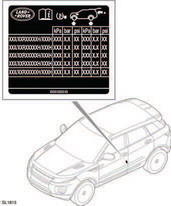Range Rover Evoque: Checking the tyre pressures

Tyre information label location.
 Tyre pressures should be
checked
regularly using an accurate pressure
gauge, when the tyres are cold.
Tyre pressures should be
checked
regularly using an accurate pressure
gauge, when the tyres are cold.
The following procedure should be used to
check and adjust the tyres pressures.
1. Remove the valve cap.
2. Firmly attach a tyre pressure gauge/inflator
to the valve.
3. Read the tyre pressure from the gauge and
add air if required.
4. If air is added to the tyre, remove the gauge
and re-attach it before reading the
pressure. Failure to do so may result in an
inaccurate reading.
5. If the tyre pressure is too high, remove the
gauge and allow air out of the tyre by
pressing the centre of the valve. Refit the
gauge to the valve and check the pressure.
6. Repeat the process, adding or removing air
as required, until the correct tyre pressure
is reached.
7. Refit the valve cap.
READ NEXT:
Keep the valve caps screwed down firmly to
prevent water or dirt entering the valve. Check
the valves for leaks when checking the tyre
pressures.
Do not drive the vehicle with
a
punctured tyre. Even if the punctured
tyre has not deflated, it is unsafe to
use, as the tyre may deflate suddenly
at any time.
Do not fit cross ply tyres.
Do not fit tubed tyres.
Do not rotate tyres around the vehicle.
If the use of tyres not recommended by
Land Rover is unavoidable, ensure
that you read and fully compl
SEE MORE:
To start the vehicle using a starting aid or a
slave battery, follow the instructions in the
sequence given.
1. Connect the positive (Red) booster cable to
the positive (+) battery terminal of the
discharged battery.
2. Connect the negative (Black) booster cable
to the vehicle earth point.
3
Removal
NOTES:
The inner quarter panel and wheelhouse is manufactured from mild steel.
The aid of a second technician is required to remove, offer up and align the
inner quarter panel and wheelhouse.
The service panel is not fully welded.
1. In this procedure, to make sure the vehicle is correctl
© 2011-2025 Copyright www.rrevoque.org


 Tyre pressures should be
checked
regularly using an accurate pressure
gauge, when the tyres are cold.
Tyre pressures should be
checked
regularly using an accurate pressure
gauge, when the tyres are cold.
